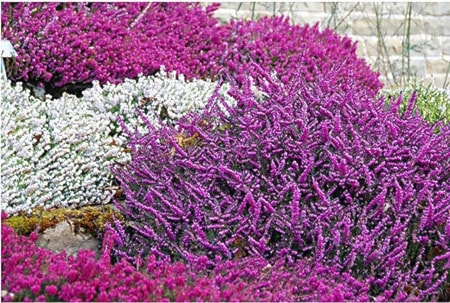The loss of all our lovely fall foliage often makes November seem far more bleak than other winter months. Winter flowering heathers are one of the best sources of winter colour and they bloom in sequence. The fresh appearance of new heather buds can really transform a dull winter garden into an attractive show place, and with a little careful planning, you can stretch that colour from November until May of the following year. There are, however, a few secrets to planting and displaying these colourful winter jewels.
One of the finest features of winter heathers is their ability to grow in areas where other plants have some difficulty. They perform best in well drained soil. Over the years, I have had the most success by preparing the planting hole with a 50 percent mixture of fine fir or hemlock bark mulch. Heathers will not tolerate heavy clay soils or wet feet, but I’m surprised at how much shade they’ll accept. Although they are sun loving plants, heathers bloom just as profusely, perhaps a little bit taller, in shady locations. One very important feature to remember is the fact that heathers have hundreds of finely textured roots. Unless you moisten the rootball thoroughly and ruffle up the root system, your heather will probably get into trouble fairly quickly. A rootbound plant has difficulty pushing its roots out into new soil unless the outer mat of solid roots has been carefully ruffled and loosened.
Winter heathers are very hardy, but we have always recommended planting them out of the coldest winter winds. Throw a bit of the new ‘N-Sulate’ fabric over your plants if we get a bitter cold spell without any protective snow covering to keep those precious blossoms looking fresh.
Heathers can be used in many ways. They make ideal ground covers when planted at 24 inch centres. They’re a good, compact summer cover that becomes a sea of colour when you need it most in the winter. They make ideal border plants and just sensational small hedges. I love to use them in containers, especially in winter colour gardens. At this time of year, heathers would certainly liven up your outdoor planters. No rock garden would be complete without a grouping of heather, and blocks of white heather planted among your evergreen beds would create quite a pleasing effect. However, the most impressive way to use heathers is to plant them as groupings in a bed by themselves. You may wish to mix in some summer blooming varieties as well. If you can blend a few colourful dwarf conifers, like ‘Blue Star’ juniper, orange toned ‘Rheingold’ cedars and ‘Sungold’ thread cypress in with the heathers, you have the beginnings of a well textured planting. Add a few carefully chosen stones and some early flowering shrubs, like viburnum ‘Pink Dawn’, corylopsis and Chinese witch hazel, and you will have created a beautiful winter flowering floral bed around your home. A few spring blooming bulbs and summer evergreen perennials, blended into the bed, will make an outstanding display during the spring and summer months as well.
Most heather flowers come in shades of white, pink and reds, but you can add a great deal of contrast by using some of the new golden foliage varieties like ‘Golden Starlet’ (white flowers), ‘Mary Helen’ (pink flowers) and ‘Eva Gold’ (dark pink flowers). Heathers have always been one of my favourite plants, and I sincerely hope you plant some newer varieties now to create more vibrant colour in your winter garden.
